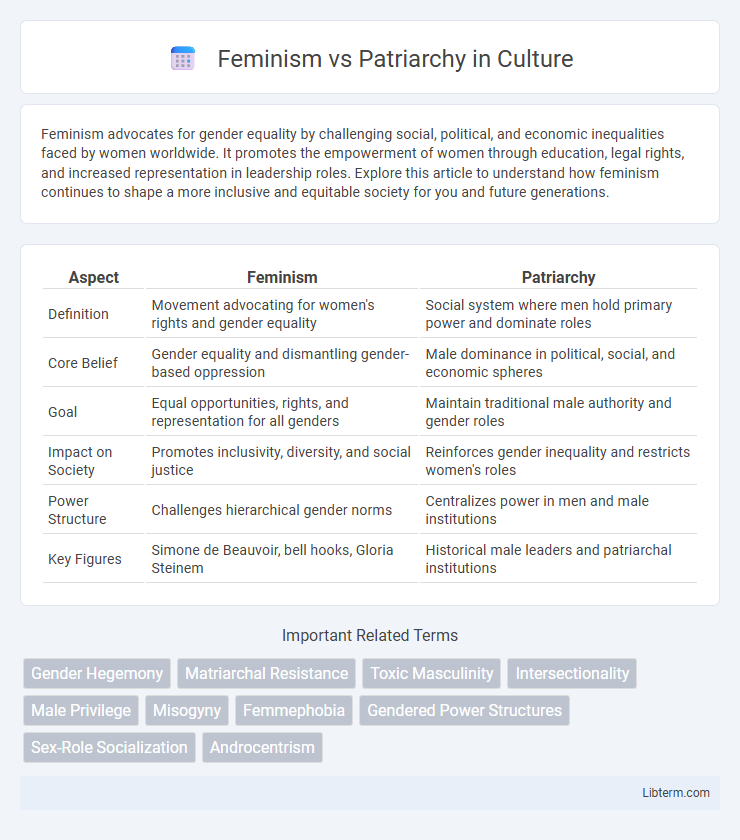Feminism advocates for gender equality by challenging social, political, and economic inequalities faced by women worldwide. It promotes the empowerment of women through education, legal rights, and increased representation in leadership roles. Explore this article to understand how feminism continues to shape a more inclusive and equitable society for you and future generations.
Table of Comparison
| Aspect | Feminism | Patriarchy |
|---|---|---|
| Definition | Movement advocating for women's rights and gender equality | Social system where men hold primary power and dominate roles |
| Core Belief | Gender equality and dismantling gender-based oppression | Male dominance in political, social, and economic spheres |
| Goal | Equal opportunities, rights, and representation for all genders | Maintain traditional male authority and gender roles |
| Impact on Society | Promotes inclusivity, diversity, and social justice | Reinforces gender inequality and restricts women's roles |
| Power Structure | Challenges hierarchical gender norms | Centralizes power in men and male institutions |
| Key Figures | Simone de Beauvoir, bell hooks, Gloria Steinem | Historical male leaders and patriarchal institutions |
Understanding Feminism: Core Principles and Goals
Feminism strives to achieve gender equality by challenging systemic patriarchy that upholds male dominance and restricts women's rights. Core principles include advocating for equal opportunities in education, employment, and political representation, alongside combating gender-based violence and discrimination. The movement seeks to dismantle ingrained social norms and legal structures that perpetuate inequality, fostering empowerment and justice for all genders.
The Roots and Structure of Patriarchy
The roots of patriarchy trace back to ancient societies where power structures centered on male dominance and control over resources, shaping social hierarchies and gender roles. Patriarchy is characterized by systemic inequalities embedded in cultural, legal, and economic institutions that prioritize male authority while marginalizing women and non-binary individuals. This hierarchical framework perpetuates gender-based discrimination and restricts access to opportunities, reinforcing the power imbalance fundamental to patriarchal societies.
Historical Context: Feminism’s Rise Against Patriarchal Norms
Feminism emerged prominently in the late 19th and early 20th centuries as a response to entrenched patriarchal norms that limited women's rights and social roles. The suffragette movement spearheaded efforts to secure voting rights, challenging legal and cultural barriers imposed by male-dominated institutions. This historical struggle laid the foundation for subsequent waves of feminism advocating for gender equality in education, employment, and reproductive rights.
Key Differences: Feminist Ideologies vs Patriarchal Values
Feminist ideologies emphasize gender equality, advocating for the dismantling of systemic oppression and promoting women's rights across social, political, and economic spheres. Patriarchal values prioritize male dominance and hierarchical power structures, often reinforcing traditional gender roles that limit opportunities for women. The key difference lies in feminism's pursuit of inclusion and equity, contrasting with patriarchy's maintenance of control and gender-based inequality.
Gender Roles: Shaping Identity in Feminist and Patriarchal Societies
Gender roles in feminist societies emphasize equality, challenging traditional norms to promote diverse expressions of identity beyond binary expectations. Patriarchal societies reinforce rigid, hierarchical gender roles that often restrict individual freedom and perpetuate male dominance. The tension between these frameworks shapes personal and social identities, influencing power dynamics and cultural narratives around gender.
Power Dynamics: Who Holds Authority?
Feminism challenges the traditional power dynamics entrenched in patriarchy, where authority is predominantly held by men across social, political, and economic institutions. Patriarchy sustains male dominance by controlling resources, decision-making processes, and cultural narratives, reinforcing gender inequality. Feminist theory advocates for redistributing power to create equitable systems that empower all genders and dismantle systemic oppression.
Feminism’s Impact on Modern Social Policies
Feminism has fundamentally reshaped modern social policies by advocating for gender equality in education, employment, and healthcare, leading to legislative reforms such as equal pay laws and anti-discrimination policies. The movement challenges patriarchal norms, promoting inclusive frameworks that address domestic violence, reproductive rights, and parental leave. These feminist-driven changes contribute to more equitable societies and improved socio-economic outcomes for marginalized genders.
Patriarchy in Culture, Media, and Language
Patriarchy dominates culture through reinforcement of male-centered narratives and traditional gender roles, shaping societal expectations and power dynamics. Media perpetuates patriarchal values by frequently depicting women in subordinate or stereotypical positions, influencing public perception and behavior. Language reflects and sustains patriarchal structures via gendered expressions and idioms that prioritize masculinity and marginalize feminine perspectives.
Ongoing Challenges: Resistance to Feminism and Patriarchy’s Adaptation
Feminism faces ongoing challenges as patriarchal systems adapt by co-opting gender equality rhetoric while maintaining power structures. Resistance to feminism manifests in legal setbacks, cultural backlash, and social stigma that undermine gender justice efforts. Patriarchy's flexibility allows it to persist by rebranding traditional roles and deploying economic, political, and media influence to stall feminist progress.
Towards Gender Equality: Bridging the Feminism-Patriarchy Divide
Feminism challenges the entrenched structures of patriarchy by advocating for equal rights, opportunities, and representation across all genders, seeking to dismantle systemic inequalities embedded in social, political, and economic institutions. Bridging the feminism-patriarchy divide requires dialogue focused on shared goals such as justice and equity, emphasizing intersectional approaches that consider race, class, and culture to create inclusive strategies. Efforts towards gender equality benefit from policy reforms, education, and community engagement that promote mutual understanding and challenge stereotypes perpetuating gender-based discrimination.
Feminism Infographic

 libterm.com
libterm.com